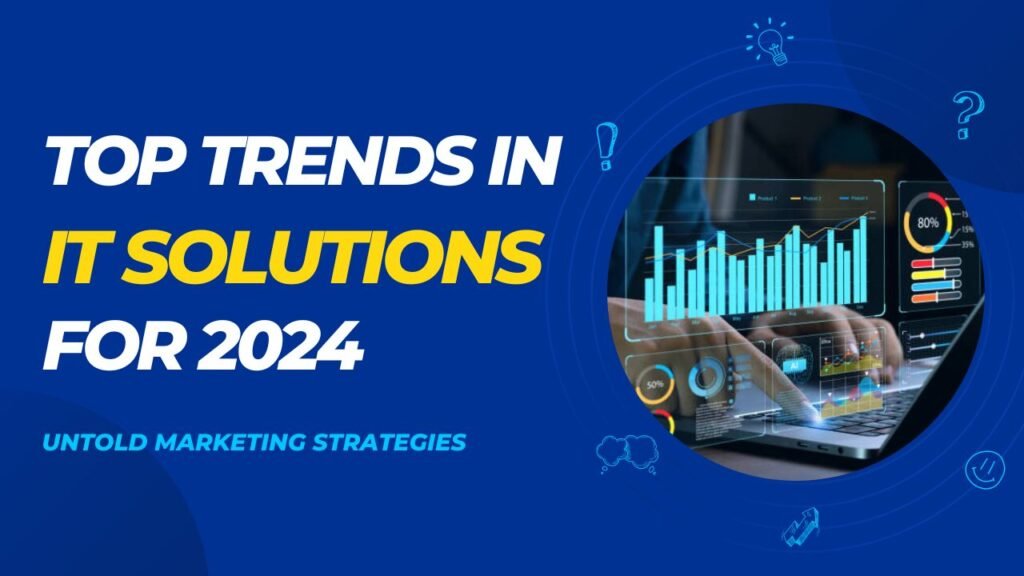As we step into 2024, the landscape of IT solutions continues to evolve at an unprecedented pace. Businesses and individuals alike must stay informed about the latest trends to remain competitive and leverage new technologies effectively. Here’s a look at the top trends in IT solutions for 2024 that are set to transform the industry.
1. Artificial Intelligence and Machine Learning
AI and ML continue to be at the forefront of technological advancements. These technologies are becoming more integrated into IT solutions, driving automation, enhancing data analytics, and improving decision-making processes.
Key Developments:
- AI-Driven Automation: Businesses are increasingly using AI to automate repetitive tasks, leading to increased efficiency and reduced human error.
- Predictive Analytics: Machine learning models are being used to predict market trends, customer behavior, and maintenance needs, allowing for proactive decision-making.
- AI in Cybersecurity: AI is playing a crucial role in detecting and responding to cyber threats in real time, making IT systems more secure.
2. Edge Computing
Edge computing is gaining traction as a means to process data closer to the source rather than relying solely on centralized cloud servers. This trend is driven by the need for real-time data processing and low-latency applications.
Key Developments:
- IoT Integration: Edge computing is essential for the Internet of Things (IoT) applications, where sensors and devices generate vast amounts of data that need immediate processing.
- Enhanced Performance: By reducing the distance data must travel, edge computing improves performance and reliability, which is critical for applications such as autonomous vehicles and smart cities.
- Security and Compliance: Processing data locally can enhance security and compliance by keeping sensitive data closer to its source.
3. Cloud-Native Technologies
Cloud-native technologies are designed to fully exploit cloud computing benefits. These technologies enable businesses to build and run scalable applications in modern, dynamic environments.
Key Developments:
- Microservices Architecture: Breaking down applications into smaller, independent services that can be developed, deployed, and scaled independently.
- Containers and Kubernetes: Containers provide a consistent environment for development and deployment, while Kubernetes automates the deployment, scaling, and management of containerized applications.
- Serverless Computing: Allows developers to build and run applications without managing server infrastructure, enabling faster development cycles and reducing operational overhead.
4. Cybersecurity Advancements
With the increase in cyber threats, cybersecurity remains a top priority. Advances in cybersecurity technologies are crucial to protecting sensitive data and maintaining trust.
Key Developments:
- Zero Trust Security: This approach assumes that threats could be inside or outside the network, and thus, every access request is verified, regardless of its origin.
- AI and ML in Security: Leveraging AI and ML to detect anomalies, predict potential threats, and respond to security incidents more effectively.
- Enhanced Identity and Access Management (IAM): Implementing advanced IAM solutions to ensure that only authorized users have access to critical resources.
5. Quantum Computing
Quantum computing, though still in its early stages, is making significant strides. It promises to solve complex problems that are currently beyond the reach of classical computers.
Key Developments:
- Increased Investment: More investments are being made in quantum computing research and development by both private and public sectors.
- Practical Applications: Early practical applications in fields such as cryptography, materials science, and optimization problems.
- Quantum Cloud Services: Leading tech companies are offering quantum computing as a cloud service, making it more accessible to businesses and researchers.
6. 5G and Beyond
The rollout of 5G networks is accelerating, bringing faster speeds, lower latency, and enhanced connectivity. This is laying the foundation for new applications and services.
Key Developments:
- IoT Expansion: 5G enables the proliferation of IoT devices by providing the necessary bandwidth and low latency for real-time applications.
- Enhanced Mobile Experiences: Improved mobile internet speeds and connectivity, enabling more robust mobile applications and services.
- Industry 4.0: Facilitating advancements in smart manufacturing, automated supply chains, and connected logistics.
7. Sustainable IT Solutions
Sustainability is becoming a critical consideration in IT, driven by increasing awareness of environmental issues and regulatory pressures.
Key Developments:
- Green Data Centers: Data centers are becoming more energy-efficient through the use of renewable energy sources and advanced cooling technologies.
- Circular Economy: Emphasis on recycling and reusing IT hardware to reduce electronic waste.
- Sustainable Software Development: Practices that focus on reducing the carbon footprint of software through efficient coding and resource management.
8. Extended Reality (XR)
Extended Reality, encompassing Virtual Reality (VR), Augmented Reality (AR), and Mixed Reality (MR), is finding more applications across various industries.
Key Developments:
- Immersive Training: XR is being used for training and simulation in industries such as healthcare, aviation, and manufacturing.
- Remote Collaboration: Enhanced remote collaboration tools that use AR and VR to create more engaging and interactive virtual meetings.
- Consumer Applications: Growth in consumer applications, particularly in gaming, entertainment, and retail, offering new ways to experience products and services.
Conclusion
The IT landscape is constantly evolving, with new trends and technologies emerging to meet the demands of a rapidly changing world. Staying ahead of these trends such as AI and machine learning, edge computing, cloud-native technologies, and advancements in cybersecurity is crucial for businesses looking to remain competitive and innovative. By understanding and adopting these trends, organizations can maximize efficiency, enhance security, and drive growth in 2024 and beyond.


